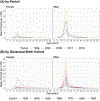Age-specific rates of onset of cannabis use in Mexico
- PMID: 34325204
- PMCID: PMC8645182
- DOI: 10.1016/j.addbeh.2021.107038
Age-specific rates of onset of cannabis use in Mexico
Abstract
Background: Over the previous two decades, the lifetime prevalence of cannabis use has risen among Mexico's population.
Aims: Estimate the sex- and age-specific rates of onset of cannabis use over time.
Design: Five nationally representative cross-sectional surveys, the Mexican National Surveys of Addictions (1998, 2002, 2008, 2012) and the Mexican National Survey on Drugs, Alcohol, and Tobacco Consumption (2016).
Setting: Mexico.
Participants: Pooled sample of 141,342 respondents aged between 12 and 65 years of which 43.6%(n = 61,658) are male and 56.4% (n = 79,684) are female.
Measurements: We estimated the age-specific rates of onset of cannabis as the conditional rate of consuming cannabis for the first time at a specific age.
Methods: Time-to-event flexible-parametric models with spline specifications of the hazard function. Stratified analysis by sex and control for temporal trends by year of data collection or decennial birth cohort.
Findings: Age-specific rates of onset of cannabis use per 1,000 individuals increased over time for females and males. Peak rates of onset of cannabis use per 1,000 ranged from 0.935 (95%CI = [0.772, 1.148]) in 1998, to 5.391 (95%CI = [4.924, 5.971]) in 2016 for females; and from 7.513 (95%CI = [6.732, 10.063]) in 1998, to 26.107 (95%CI = [25.918,30.654]) in 2016 for males. Across decennial birth-cohorts, peak rates of onset of cannabis use per 1,000 individuals for females ranged from 0.234 (95%CI = [0.078, 0.768]) for those born in the 1930s, to 14.611 (95%CI = [13.243, 16.102]) for those born in the 1990s; and for males, from 4.086 (95%CI = [4.022, 7.857]) for those born in the 1930s, to 38.693 (95%CI = [24.847, 48.670]) for those born in the 1990s.
Conclusion: Rates of onset of cannabis increased over the previous two decades for both females and males but remained higher for males. Across recent cohorts, the rates of onset have increased at a faster rate among females than males.
Keywords: Age-specific rates of onset; Cannabis; Mexico; Time-to-event flexible parametric models.
Copyright © 2021 Elsevier Ltd. All rights reserved.
Conflict of interest statement
Figures




References
-
- Guerrero Sanchez, Alejandro Robles Soto, Nadia Fukushima Taniguchi, Eiji A, Ferrer Alarcon, Judith E, editors. Informe Sobre la Situacion del Consumo de Drogas en Mexico y su Atencion Integral 2019 [Internet]. Secretaria de Salud, Comision Nacional Contra las Adicciones; 2019. Available from: https://www.gob.mx/cms/uploads/attachment/file/477564/Informe_sobre_la_s...
-
- Committee on the Health Effects of Marijuana: An Evidence Review and Research Agenda, Board on Population Health and Public Health Practice, Health and Medicine Division, National Academies of Sciences, Engineering, and Medicine. The Health Effects of Cannabis and Cannabinoids: The Current State of Evidence and Recommendations for Research [Internet]. Washington, D.C.: National Academies Press; 2017. [cited 2020 Aug 20]. Available from: https://www.nap.edu/catalog/24625 - PubMed
-
- Hall W, Renström M, Poznyak V, World Health Organization, Management of Substance Abuse Team. The health and social effects of nonmedical cannabis use [Internet]. 2016. [cited 2019 Dec 9]. Available from: https://public.ebookcentral.proquest.com/choice/publicfullrecord.aspx?p=...
-
- Degenhardt L, Charlson F, Ferrari A, Santomauro D, Ers kine H, Mantilla-Herrara A, et al. The global burden of disease attributable to alcohol and drug use in 195 countries and territories, 1990–2016: a systematic analysis for the Global Burden of Disease Study 2016. Lancet Psychiatry. 2018. December;5(12):987–1012. - PMC - PubMed
Publication types
MeSH terms
Grants and funding
LinkOut - more resources
Full Text Sources

